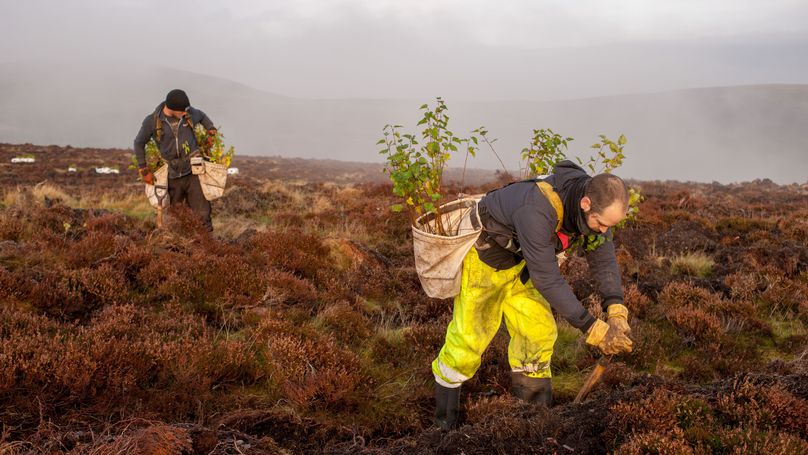Bamff Estate, a few miles north of Alyth in Perthshire, is a mixed estate that has been experimenting with rewilding for more than 20 years.
In 2002, Bamff was the first estate to import beavers from Norway, an unpopular decision in some quarters but a bold one that has transformed part of the property into a series of ponds and swamps, creating a biodiverse wetland landscape like few others in the Highlands. Watching this transformation has attracted great interest. In addition to farming, eco-tourism in the form of holiday cottages and ‘glamping’ has become a main source of income.
Since 1995, some 90 hectares of Caledonian pinewood has also been planted around Balduff Hill in the foothills to the south of Glen Isla. The owners, Paul and Louise Ramsay, recently decided to complete this work and engaged Galbraith to design a new native woodland on the remaining area of hill.
In truth, planted native woodlands are rather poor imitations of the real thing because the complex soil fauna that develops beneath a continuous, long established tree canopy is largely absent from bare land. Some would argue that the trees themselves are the least important component of old growth native woodland – most of the biodiversity occurs below ground where a myriad of fungal mycorrhiza and other micro-organisms play an integral part in the cycling of nutrients, forming complex, interdependent relationships with the trees and other vegetation.
All we can hope to do with new native woodland is create a seed source that perpetuates successive generations of trees and allows the site to slowly re-establish this complexity over the coming decades. From the outset, the aim is to match the right species to the site and establish the woodland quickly with as little soil disturbance as possible.
Older woodland grant schemes sometimes limited species composition and did not enable some sites to meet their full potential. Scots pine is one element of the woodland mosaic that made up the post-glacial Caledonian forest but can end up as the dominant feature to the detriment of other species. At Bamff, there was scope to design a more diverse scheme reflecting the transition from acid grassland to moorland further up the hill with oak and pine co-existing on the same site.
The boundary of the site is located at the very edge of the Forestry Commission’s Pinewood Zone, a line loosely drawn from pollen analysis denoting the natural extent of Caledonian Scots pine forest. From grassland at 280 metres, the land rises to dry heathland and the summit of Balduff Hill at 425 metres. Well drained brown earth soils grade into infertile podzols above about 320 metres.
There is disagreement among ecologists about whether oak would originally have colonised podzolic soils but it will grow adequately, if slowly, beyond 350 metres with the main limiting factor being exposure and fertility. The soil nutrient status of upland rough pasture is typically low but will improve as the new woodland matures. Of the two native oaks, sessile oak tolerates exposure more readily than pedunculate oak.
Another limiting factor is the time constraint imposed by the grant scheme that requires trees to be fully established within a narrow time period.
At Bamff, sessile oak was ‘zoned’ with the largest element below 320 metres, a much smaller one above 320 metres and none beyond 360 metres to achieve a reasonable balance between pushing the capabilities of the site and minimising liability in relation to the grant scheme. All oak was treated with slow release fertiliser at the time of planting to speed up establishment.
The other major component was silver and downy birch with Scots pine, rowan, holly, hazel, aspen and juniper as secondary species also zoned appropriately according to site conditions and altitude. Scots pine is the dominant species in one heather-dominated corner of the site.
Aspen is under-represented in literature that describes the likely composition of native woodland because it does not survive well in pollen records. However, it is an important species in boreal forests across the northern hemisphere and at one time was probably more common in Scotland than it is today. Most of the aspen in the scheme will be added gradually as local stock becomes available.
The scheme was split into two phases. The first phase was completed in November 2018 and the final phase will be completed later this year. Ground preparation is needed to relieve soil compaction, control weeds and strip back rank heather. Minimal intervention was achieved with a combination of inverted excavator mounding in grassland areas and a tractor mounted twin disk scarifier in heather dominated areas. This work was carried out by Robertson Fencing, Pitlochry.
The perimeter of the site was deer and rabbit fenced by Jim Drummond Fencing, Dunkeld and the planting carried out by a team from Mike Todd Forestry, Spittalfield. The planting stock was supplied by Alba Trees, Haddington.
The second phase of the planting will round off the creation of just over 200 hectares of native woodland on Balduff Hill and is the culmination of the owners’ long-term vision for rewilding this part of the property.
